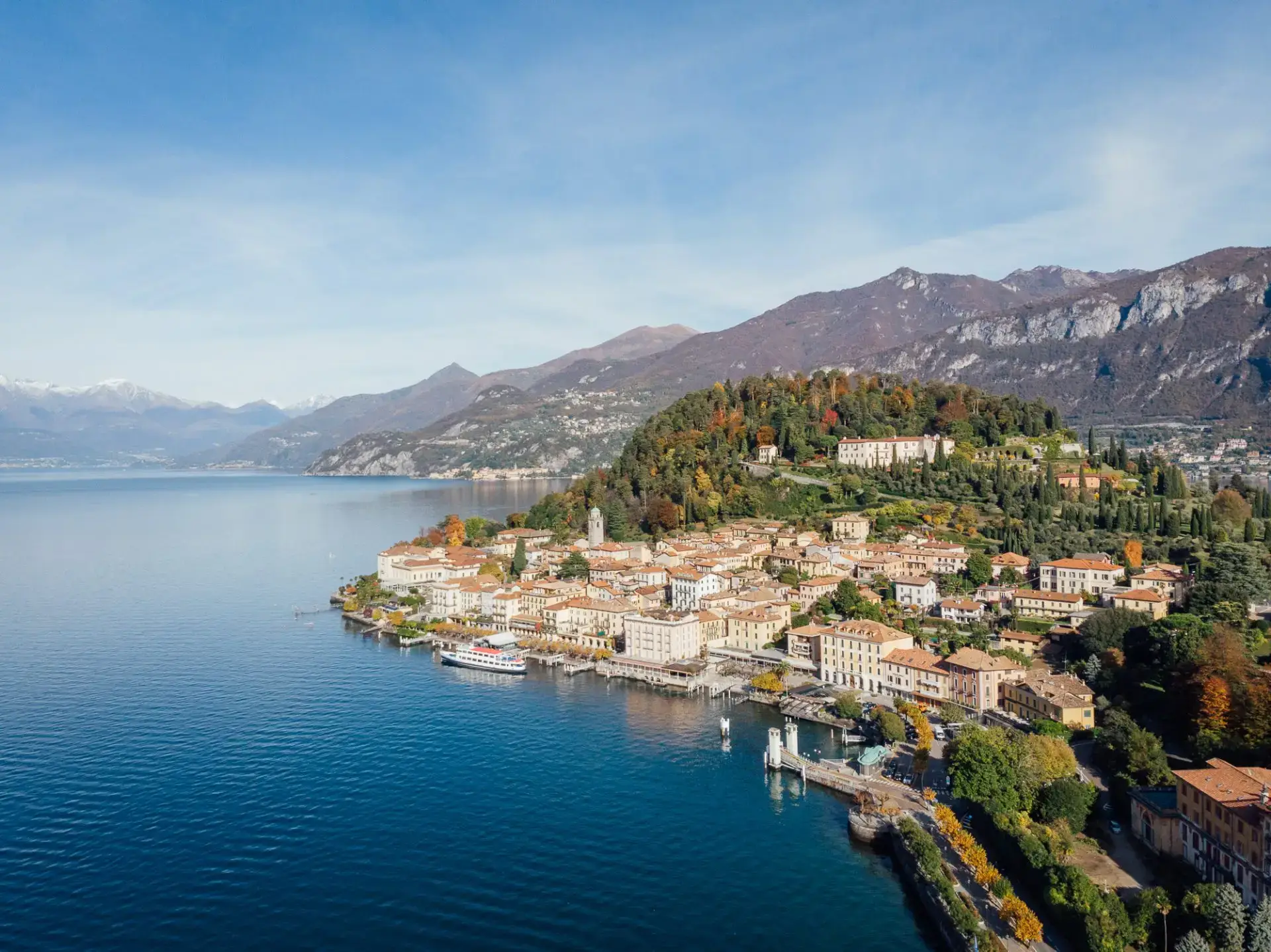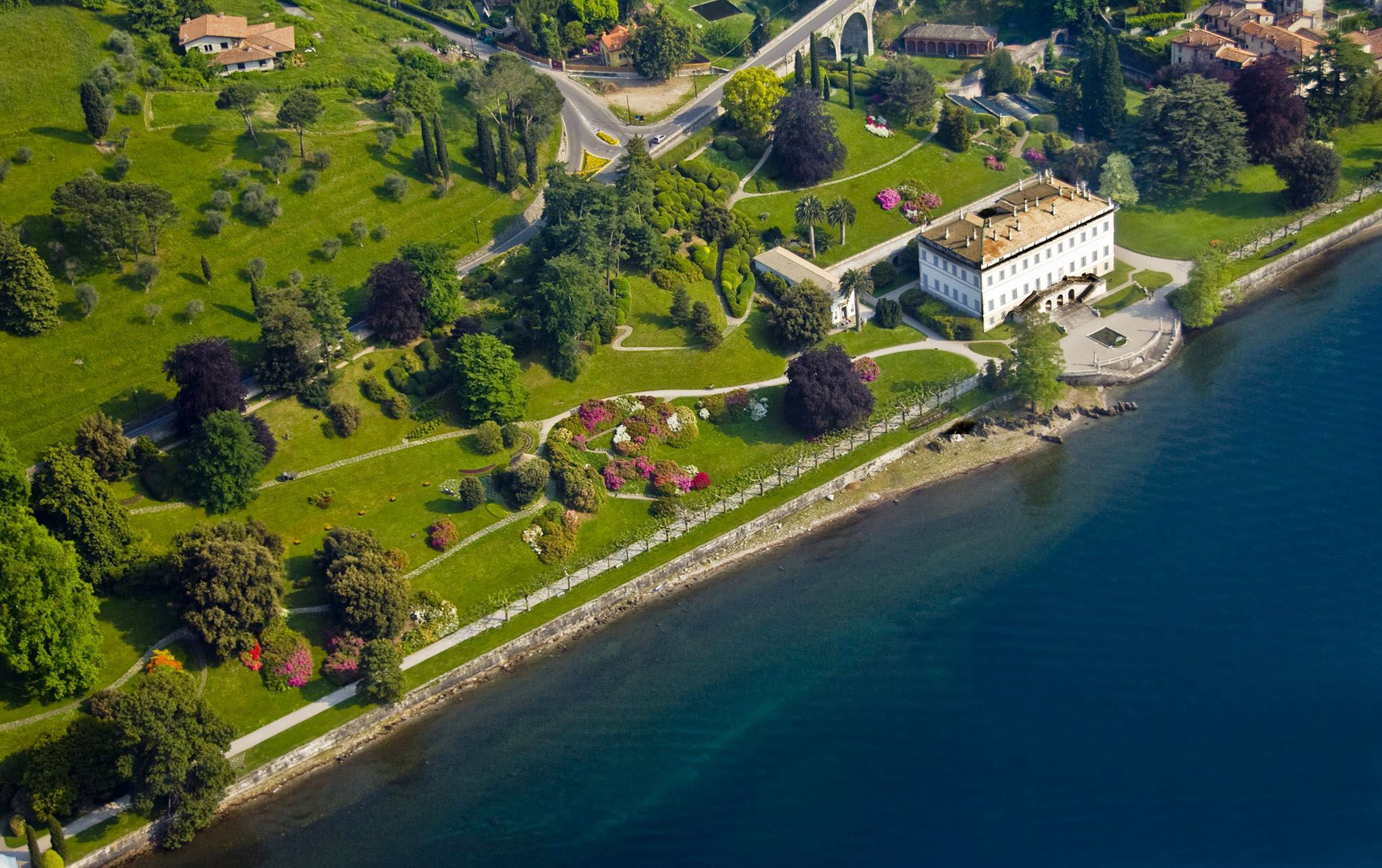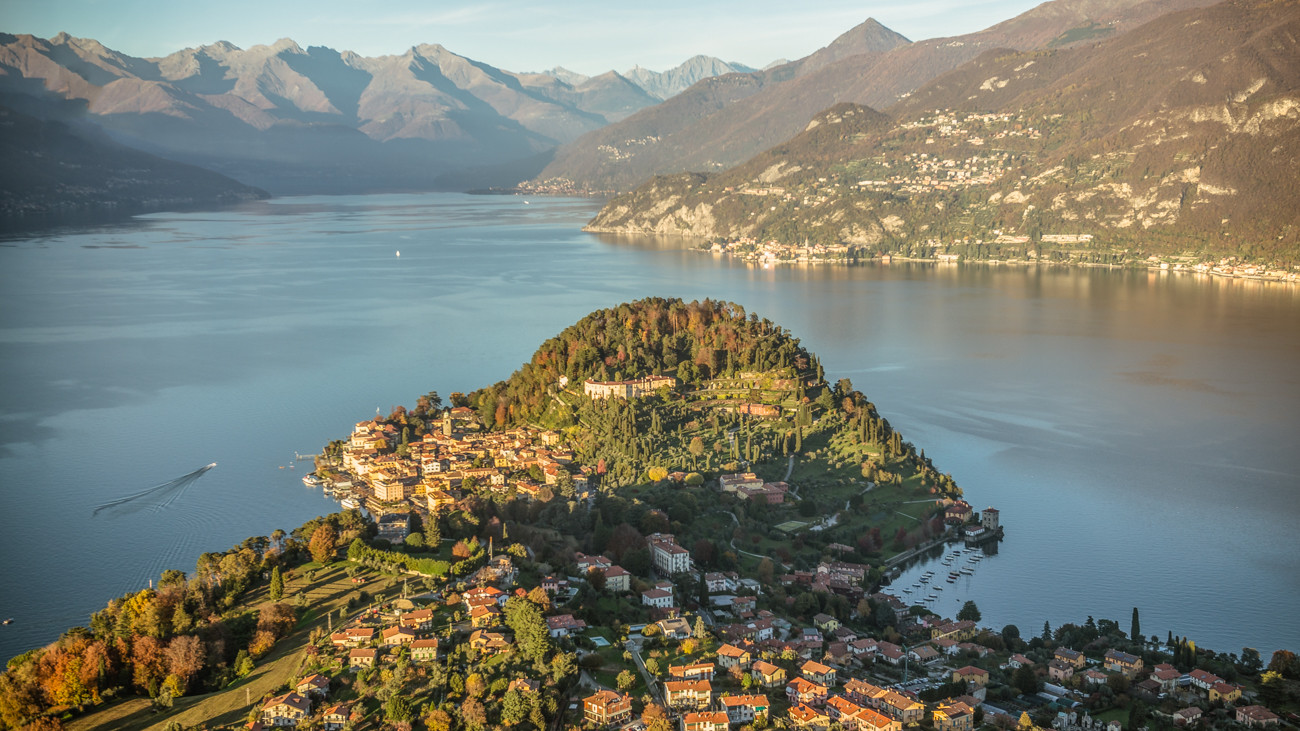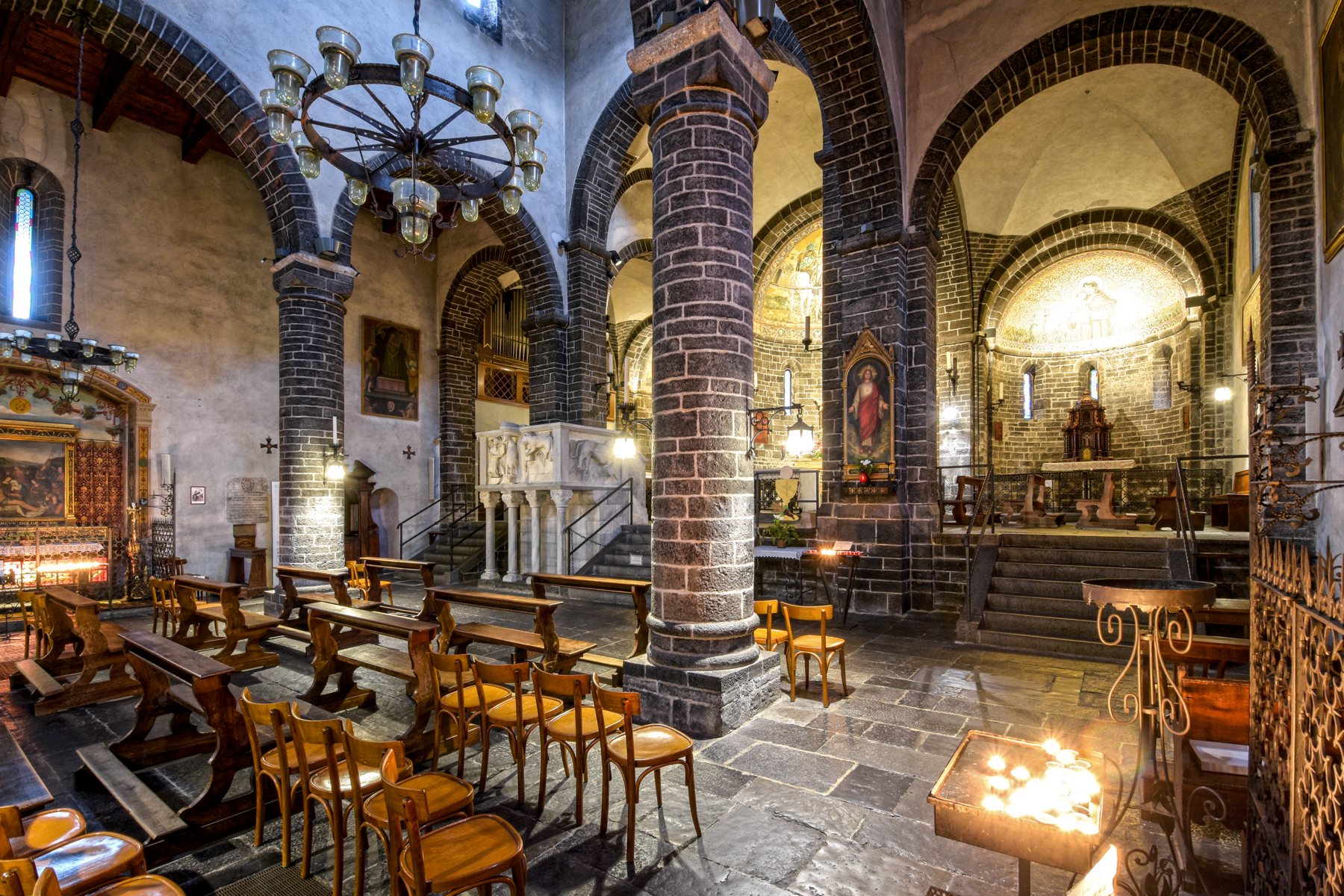
What to do and see in Bellagio

The village of Bellagio, known as the “Pearl of the Lario”, boasts a unique position, lying at the top of the so-called Larian Triangle, at the base of the promontory that divides the lake into the branches of Como and Lecco.
It is considered one of the most famous and elegant villages of Lake Como and with its beautiful villas and gardens, the mild climate and the naturalistic-environmental features of great charm is able to surprise and enchant thousands of tourists from all over the world every year.
The village extends from the most famous lake hamlets, such as the Borgo of Bellagio, Loppia, San Giovanni and Pescallo, to the top of Monte San Primo, the highest mountain (1,682 metres) within the Larian Triangle.
Its origins, but also its fame, date back to Roman times and its enchanting and strategic position has written its history.
Walking around its streets and hamlets you will discover unique wonders and extraordinary views, you will relive fascinating atmospheres and taste part of the elegance that over the centuries has made Bellagio one of the first Italian tourist resorts to become truly international.
Here are our advice and suggestions on what to do and visit in this beautiful village on Lake Como.
___
1. Historical Hamlet of Bellagio
The historical centre of Bellagio, also called “il Borgo“, with its numerous small shops situated along narrow stepped streets, interspersed with endless passageways and arcades, is famous all over the world and attracts thousands of tourists every year.
The atmosphere that one breathes among its streets is that of a very lively and elegant village, with a sumptuous and international past, made of high-profile cultural, artistic and social events. Theatres with a busy schedule, large and very luxurious hotels, which already in the 19th century competed for elegance with those of the main European capitals and high quality craft shops have made the history of this town.
Famous personalities of various kinds, musicians, writers, artists and even emperors have passed through here. And in the last few years many actors of the cinema have also suffered the charm of this village.
Walking around the beautiful Piazza Giuseppe Mazzini, the main square of the town, where the boats dock and walking through its cobbled streets you will immediately realize how, still today, Bellagio is able to offer its visitors the pleasure of staying in beautiful and historic luxury hotels, enjoying the good food of its renowned restaurants and shopping in boutiques and high quality craft shops.
In this regard, not to be missed is the ancient Salita Serbelloni, a renowned street full of colourful little shops and certainly one of the most photographed views of the historical hamlet.
Among its hotels stands out the Grand Hotel Villa Serbelloni built as a private villa in 1852 for the Frizzoni family and became a hotel in 1872 with the name of Grand Hotel Bellagio. When Villa Serbelloni became part of its property in the early 1900’s, it absorbed the name and still retains it today. It is worth stopping to admire the entrance, a small taste of the beauty of its interior.
In order not to miss any of the most interesting points of the historical centre of Bellagio, we suggest you to follow the itinerary to discover the Borgo.
2. Attractions
Villa Serbelloni Park
One of the unmissable attractions of Bellagio is certainly the Park of Villa Serbelloni, situated on the steep promontory that separates the two branches of the lake, where, according to tradition, Pliny the Younger owned a villa called Tragoedia.
Inside it stands the building complex of Villa Serbelloni, today the seat of the Rockefeller Foundation and a place of culture, where artists and intellectuals from all over the world are hosted every year. Here and in the little houses for artists scattered around the park, they find the intimate and quiet environment ideal for finding inspiration.
The villa, unfortunately not open to visitors, is characterised by simple architectural lines and a succession of elegant halls with vaulted and coffered ceilings, carefully decorated in the style of the 17th and 18th centuries.
It is instead possible to visit its park, a suggestive tangle of about 18 km of avenues and alleys immersed in stretches of dense woodland of native and exotic vegetation and embellished with terraces and statues, from which you can enjoy a superb view of the branches of Lake Como and Lecco.
Walking among pines, oaks, firs, holm oaks, osmanthias, myrtles and junipers you climb gently up towards the upper part of the park and from time to time the vegetation thins out opening up on panoramic viewpoints overlooking the two branches of the lake, offering perspective views of the slopes of the hill where, in the summer, the rose gardens bloom in their colourful varieties.
Along the winding avenue that climbs up to the villa, the rocky soil has not prevented the construction of terraces and flowerbeds where geometrically pruned yews and box trees grow. Towards the top of the park you can finally walk along long rows of cypresses and some palms of considerable size.
Opening Hours
The park is usually open from March to November and can only be visited with a guided tour organised by Promobellagio and included in the ticket price.
Guided tours take place only twice a day: at 11 a.m. and at 3.30 p.m.
In case of bad weather they are cancelled.
Booking is compulsory online on Promobellagio.
—
Villa Melzi

Another artistic and botanical jewel to see in Bellagio is the Villa Melzi d’Eril, built in the early nineteenth century in neoclassical style at the behest of Francesco Melzi d’Eril.
The gardens of Villa Melzi extend along the lake shore and blend harmoniously into the hilly landscape of the Bellagio peninsula. Inside them the villa, the chapel and the greenhouse of the orange trees, now a historical museum, are a splendid expression of neoclassical style, and as such declared a national monument.
Also in this case the part that can be visited are the gardens, unique for their position by the lake and for their elegance.
Crossing the entrance, the visitor is welcomed by one of the most characteristic corners of the park, a small lake of water lilies, surmounted by an iron bridge and surrounded by brightly coloured maples, particularly suggestive in the autumn season.
Just beyond a Moorish style kiosk with an enchanting view of Bellagio and, opposite, the monument to Dante and Beatrice by Comolli, which seems to have inspired Liszt’s Sonata to Dante. Along the lake, next to a splendid Pinus montezuma, there is an ancient Egyptian statue of the goddess Pacht and others from Napoleon’s Egyptian campaign.
The walk along the avenue of the plane trees, pruned as an umbrella, ends in the terrace in front of the villa, framed by ancient statues. The family chapel, designed by Albertolli, delimits the garden with its splendid neoclassical monuments. The orangery is now used as a museum of relics and prints of the first Italian Republic.
In the park, exotic and rare essences alternate with centuries-old trees, camellias, rhododendrons and azaleas. Among the most precious plants are Liriodendron tulipifera, Lebanon cedars, red beeches, camphor trees, Ginkgo biloba.
Opening Hours
The gardens of Villa Melzi are usually open to the public from March to November.
—
Tower of the Arts
If you are fond of exhibitions, a visit to the Tower of the Arts is a must. It was opened in 2010 in what was the Torre San Giacomo, a building in the south-east corner of the current Piazza della Chiesa and which was part of the defensive system of the ancient castle overlooking the Bellagio promontory.
Born as a place to promote the historical-artistic and cultural heritage of the territory, the Tower of the Arts of Bellagio hosts throughout the year artistic events of various kinds, including exhibitions of local, national and international artists, seminars, small theatrical performances or poetry recitals, literary and artistic competitions, conferences and book presentations.
—
The Punta Spartivento

It is the extreme tip of the town and it is called Punta Spartivento (“tip that divides the winds”) because it is the point that divides Lake Como into three branches: the Lecco branch on the right, the Como branch on the left and in the middle the northern part of the lake; all framed by the beautiful chain of the Larian mountains admirably described by Alessandro Manzoni in his masterpiece The Betrothed (I Promessi Sposi).
It can be reached quickly from the historiacl hamlet and the panorama it offers is one of the most beautiful on the lake.
—
In the hamlet of San Giovanni in Bellagio, the carpenter Ivan Gilardoni, a lover of vintage bikes, has transformed his house into a tourist attraction, hanging on the facade the so-called “flying bikes”, more or less historical models of bicycles collected over the years and restored by him.
Among the almost one hundred examples of vintage bicycles, purchased at markets and fairs or recovered directly from landfills, there is no lack of historical pieces, a Bianchi racing bike, the vehicle used in the past by firemen, the Milanese sweeper and even the two-wheeler of the Swiss army.
3. Churches
Church of S. Giacomo

The Church of San Giacomo is a wonderful example of Romanesque-Lombard art (XII century) built between 1075 and 1125 by the Maestri Comacini.
Externally the church, despite the twentieth century renovations, reflects the characteristics of the Romanesque architecture of Como. The building is entirely in grey stone, with three naves, with apses decorated with hanging arches and a mighty sixteenth-century bell tower.
The interior houses numerous works of art, including paintings, altarpieces and statues. In particular they are worth mentioning:
- mosaics of the early 20th century
- rich altar of the end of ‘500
- an Archaic Crucifix of the XII century
- the triptych by Foppa (1432)
- the “Christ deposed”, polychrome wooden statue of the Spanish-Baroque school
- paintings depicting Saints and the Education of the Virgin Mary
- a canvas with the Immacolata, a work attributed to the Recchi brothers painters
- a painting depicting a black Madonna with Saints John the Baptist, James, Francis, Jerome
- a Deposition from the school of Perugino, under which a seventeenth-century statue of the dead Christ is placed
- the Holy Family, recently attributed to Orsola Caccia (daughter of Moncalvo)
- a medieval stone cross (X/XII century) and the canvas of the Martyrdom of St. James of Argonio Aragonio (1607)
- the Baptistery, with a mosaic of recent workmanship, the subject of which recalls the Baptism of Christ made by Bergognone for the Basilica of San Giovanni Battista in Melegnano
—
Church of San Giorgio
The Church of San Giorgio is a small church situated in the upper part of the historical centre of Bellagio, a few steps from the town hall.
It too, like the Church of San Giacomo, the main church of the town, dates back to the XI-XII century (it is dated between 1080 and 1120).
The style of the period in which it was built is reported in the stone ashlar perimeter walls, in the conch windows and in the small portal. Originally the apse and the altar were facing east, but were then moved to the opposite side, thus moving the entrance towards the street.
The bell-tower is unusual, along Salita Genazzini.
Looking at its interior, you can see an interesting fresco of the Madonna della Cintura (depiction of the Virgin giving the belt to a monk), dating back to the XI century, and a wooden statue of her, which is traditionally carried in procession on the second Sunday of September. Both representations are the expression of a very strong cult in the area, confirmed by the presence of the Confraternita dei Cinturati, located in the oratory attached to the church.
—
Church of Santa Maria of Loppia
The Church of Santa Maria of Loppia is of medieval origin. It was probably founded towards the end of the X century and underwent considerable modifications over the years.
Next to the church the Benedictine nuns, owners of the property, built their convent there; the buildings were abandoned in the 17th century and the property passed to private owners.
Today the church is part of the park of Villa Gerli and is closed to the public.
—
Church of San Giovanni
The Church of St. John the Baptist in Bellagio was built from 1584 (partly in 1685) on the site of a previous temple dedicated to the Baptist, dating back to at least the 10th century.
On the beautiful lakeside square, adjacent to the characteristic pier of San Giovanni, stands out its grandiose baroque facade, flanked by a five-bell tower.
If you have the opportunity to admire its interior, do not miss in the first chapel on the right a beautiful 17th century wooden statue of the Assumption of the Virgin Mary and the relics of St. Primo, whose simulacrum is inside a shrine with gilded bronze decorative elements.
Also worth mentioning, at the height of the presbytery, the statue of St. John the Baptist, made in 1974 by Giovanni Tavani in Carrara marble, the high altar decorated with a gilded wooden altarpiece with the Risen Christ and a statue of the Immaculate of the 17th century in marble, attributed to Ercole Ferrata by Pellio d’Intelvi.
This last work was donated to the church of San Giovanni by Countess Melzi d’Eryl at the end of the nineteenth century.
Finally, to be noted is an altarpiece depicting the Risen Christ and Saints, a work of 1530 attributed to Gaudenzio Ferrari, a gift from the Frizioni family, the counter-façade, on which the organ and a fresco of the Baptism of Christ and the vault of the nave are placed, decorated with paintings depicting four episodes of the Life of John the Baptist, the Transfiguration and the Evangelists.
—
Church of S. Maria Annunciata in Breno
The Church of Santa Maria Annunciata di Breno rises in Visgnola, another small hamlet of Bellagio, on the side of the promontory overlooking the Lecco branch.
The origin of the building is unknown. The church is remembered in the acts of pastoral visits of the XVI century, but in reality the period of its foundation is not known. What is known is that it became a parish church, in the second half of the nineteenth century, instead of the Church of San Martino.
Around its construction there is even a legend that goes back to its origins to the will of a lord of the Castle (the present Villa Serbelloni) who, at the fountain of the birds (the one next to the present church, from which water comes out of the mouth of two granite heads with human features), would have been miraculously healed from the infirmity of his legs.
Impressed by the grace he received, he ordered his men to dig in front of the spring: it was thus that an image of Mary with Child was brought to light, which is said to be the one still visible below the central window above the choir. From there it was decided to build a church there and dedicate it to Our Lady.
Inside you can admire some beautiful paintings on canvas, dating back to the end of the fifteenth century, and an icon with compartments behind the high altar, the work of a local author.
—
Church of SS. Ambrogio and Materno
The Church of Santi Ambrogio and Materno is located in Civenna, a small hamlet of Bellagio at the foot of the Ghisallo Pass.
The building dates back to the 17th century and is located in a raised position; it is accessed, in fact, by a double flight of stairs: the first one leading to the small churchyard, the second one allowing direct access to the building.
Note the façade, divided into two orders, surmounted by a tympanum; in the lower band you can see the portal preceded by a short pronaos with columns and a tympanum with a lowered arch. On the left there is a curvilinear body: inside there is the chapel dedicated to the Madonna of Lourdes.
Along the left side you can admire the imposing bell tower.
4. Museums
Museum of Navigation Instruments
This small themed museum is located in the village of San Giovanni of Bellagio, in an old tower house and is definitely worth a visit.
Born from the private collection of Gianni Gini, writer and expert navigator, who has dedicated 40 years of research and passion to it, it collects more than two hundred precious objects that in the past centuries have allowed man to orient himself at sea and navigate. Among these are 18th century Venetian-made telescopes, sundials, compasses, marine chronometers, an armorial sphere, a beautiful brass planetarium and nineteenth century logbooks.
But the Museum of Navigation Instruments is also a place where cultural and literary events are held thanks to the creation, inside it, of the Plinio il Giovane Literary Café, created and furnished by the designer Mario Prandina, aka Plinio il Giovane.
—
The Madonna del Ghisallo Cycling Museum
The Madonna del Ghisallo Cycling Museum is a museum in the heart of the Larian Triangle, in Magreglio, adjacent to the Ghisallo Sanctuary dedicated to the Madonna patron saint of cyclists.
The Museum was inaugurated on 14th October 2006 and Sergio Zavoli dedicated these words to it: “ideally, it relives the world of the racing bike, with men and deeds that have elected it as proof of how fatigue and courage, pain and joy, are nature and image of cycling”.
5. Walks
For lovers of walking and trekking, on the promontory there are numerous itineraries and paths of varying difficulty, from simple routes for amateurs to more demanding excursions. The Tourist Office of Bellagio offers a wide range of proposals for walking, cycling and itineraries.
We recommend the interesting “Tour of the Hamlets”, ideal for exploring the area around the historical centre of Bellagio.
A tour of the hamlets of Bellagio
Easy route of about 2 hours to discover some of the hamlets of Bellagio: Pescallo, Regatola, Guggiate, San Giovanni and Loppia.
The Tour of the Hamlets of Bellagio is a beautiful historical and scenic itinerary ideal for exploring the area around the hamlet and admiring its most interesting points of interest, walking through narrow streets and lanes and breathtaking panoramic views.
The Church of SS Biagio and Andrea, Villa Giulia, the plaque in memory of Alessandro Volta, the mausoleum, the oratory of Sant’Andrea, the Church of Santa Maria di Loppia and Villa Melzi are just some of the wonderful attractions you will encounter along the way.
The Tourist Office, located in Piazza Mazzini, is the starting point.